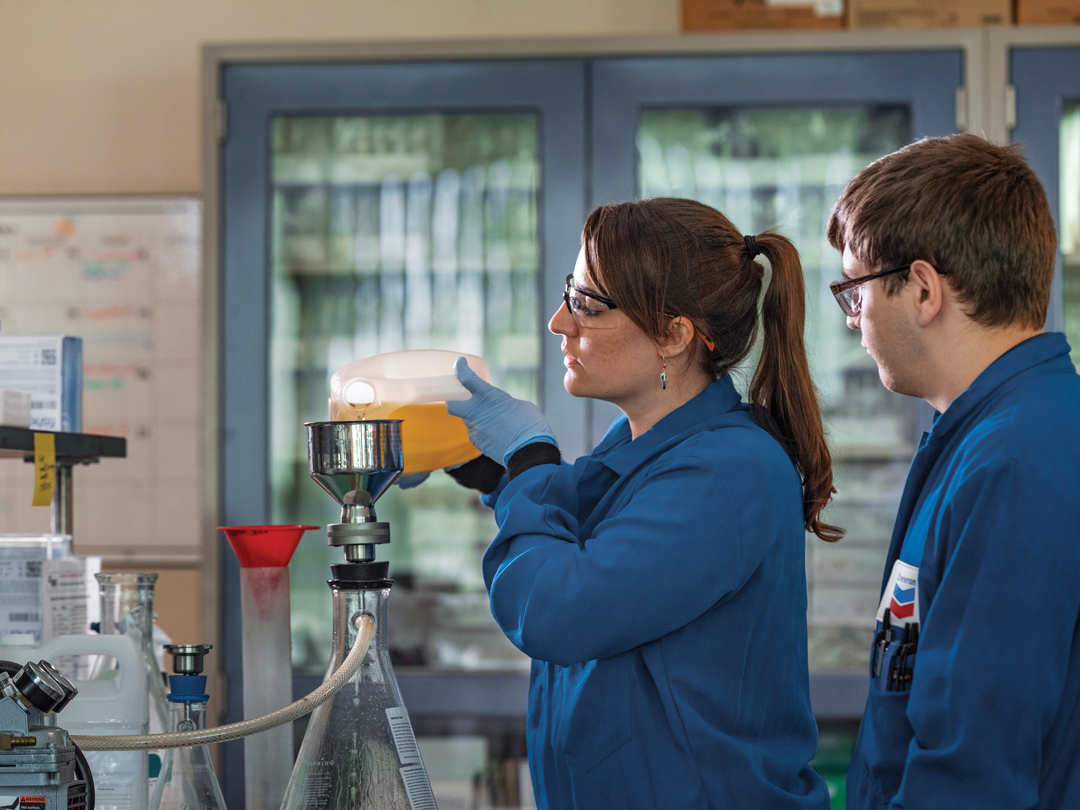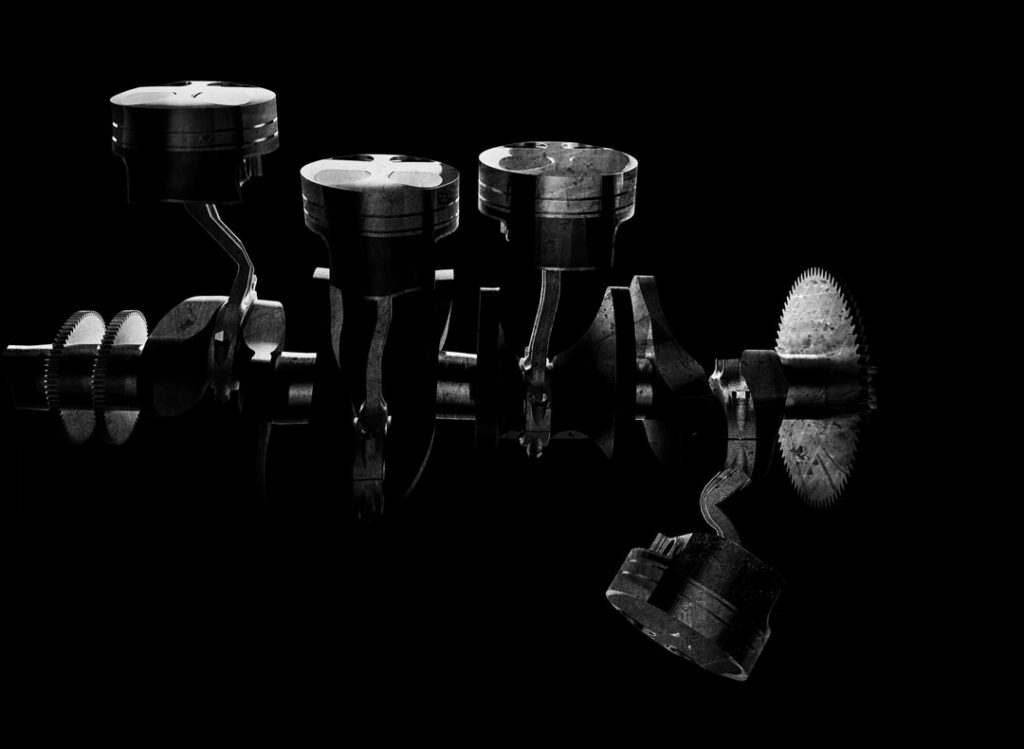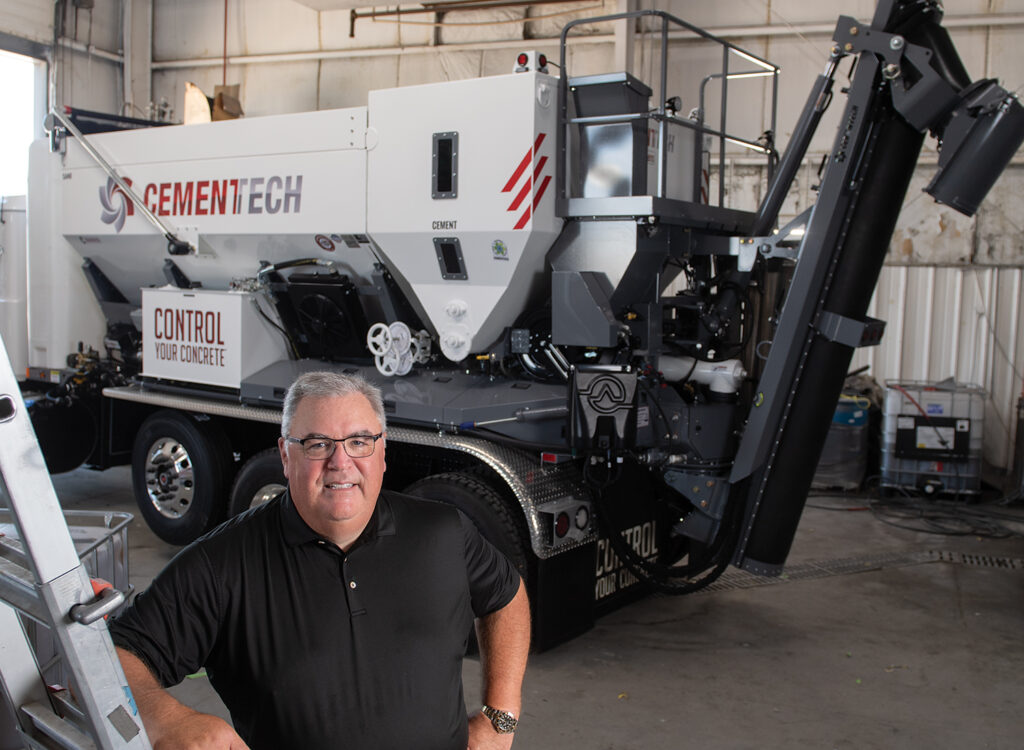From trash to treasure: Chevron REG researches biodiesel advances

What began as a way for farmers to add value to their unused crops in the 1990s is now part of a multibillion-dollar company that partners with Iowa State University.
In 1996, farmers at the West Central Cooperative in Ralston were looking for new markets for their unused soybean oil. The co-op built a biodiesel plant, converting the soybean oil into biodiesel fuel under the brand name SoyPOWER. After its initial success, the group opened one of the world’s largest continuous-flow plants for processing soybean oil into biodiesel fuel and launched Renewable Energy Group in 2003. The company acquired several biorefineries across the country, including one in Newton. In 2012, the company went public and reached $1 billion in annual revenue. In 2017, REG produced its 2 billionth gallon of biomass-based diesel. Then in 2022, REG was acquired by Chevron for $3.15 billion, becoming Chevron Renewable Energy Group.
Today, Chevron REG researchers are settling into the company’s newest facility, the Ames Technology Center. In June, a grand opening was celebrated for the 45,000-square-foot center, which is adjacent to two Chevron REG office buildings. Among the nine biorefineries owned globally by Chevron, two are in Iowa, one in Mason City and one in Newton.
There are 275 employees working at the Chevron REG Ames campus, where they focus on developing technology that can produce lower-carbon fuels by using renewable sources, like fats and oils. Parent company Chevron is investing more than $8 billion to create a higher return on “lower carbon businesses,” which includes converting byproduct fats and oils, known as feedstocks, into biodiesel and renewable diesel. In the new Ames facility, 25 employees focus on scaling and commercializing biodiesel, renewable diesel, sustainable aviation fuel and other biofuels. The company recently expanded renewable diesel production at its Geismar, La., facility, from 90 million gallons to 340 million gallons per year. That kind of production increase is the result, in part, of the research done in Ames.
“The mission of the lab and the folks who are associated with the work being done here is to accelerate the development of technologies and technical capabilities to deliver higher returns for our lower-carbon transportation fuels, specifically, biodiesel and renewable diesel,” said Martin Haverly, director of research and development and innovation at Chevron REG in Ames.
Ames lab
The Ames center is one of two Chevron technology centers in the country. The other is Chevron’s Richmond Technology Center in Richmond, Calif., where more than 170 doctoral-level scientists research automotive engines at the 1.2 million-square-foot facility.
In Ames, the new building has 27,000 square feet of lab space. Ames Chevron REG researchers previously worked in a 4,000-square-foot lab, making the new space a 575% increase in space for workers. The new facility has a 40%-50% utilization rate, leaving room for growth and expansion, Haverly said.
“We’re well positioned for whatever is going to come, and also the future that we create through the innovations coming out of this building,” he said.
At the lab, researchers work on several scientific processes that involve identifying the materials within the biofuels and improving the catalytic process used to create the fuels. Renewable diesel is a low-carbon fuel that, through a catalytic process utilizing heat, pressure and hydrogen, known as hydrotreating, can convert feedstocks into a hydrocarbon fuel that is chemically similar to traditional diesel, according to the U.S. Department of Energy. Chevron REG researchers are working on ways to improve that catalytic process.
At the Ames lab, safety comes first. The building is outfitted with automated control systems for gas monitoring, chemical spill detection, alarm systems and more. The larger space gives researchers more room for more advanced experiments. The previous building had 11-foot-high ceilings, while the new center has 22- to 27-foot-high ceilings, allowing scientists to complete distillation, which can separate liquids and remove unwanted components to improve the quality of biodiesel. The new building has wide hallways to easily transport experiments and projects.
“When we talk about things like separations, one of the primary separation techniques that we use is distillation. And distillation is typically done in columns; we use these really tall vessels. Now we’re able to install an actual distillation column in here and run it,” he said. “The distillation process is one that has led to the creation of new products.”
Something as simple as a higher ceiling could translate into research breakthroughs for Chevron REG.
“We weren’t able to do it before, and that type of work is critical, because we’re really pushing the envelope always in the industry,” Haverly said. “We’ve been an industry leader for renewable fuels for a long time. High-quality fuels typically means more and more separation. That’s something that we’ve pioneered. We’re the first group to really lean in on distillation of biodiesel.”
The facility also has a hydrogen generator. Chevron REG researchers use hydrogen as a catalyst to react with feedstock to make a specific hydrocarbon fuel, he said.
“It’s a huge advancement, because [without the generator] instead we would have to have large stores of hydrogen, like large tubes and vessels of hydrogen, and those have a lot of potential energy. They could light on fire. It’s under high pressure, all those things. Instead, we only generate hydrogen when we need it,” he said.
Researchers now have warehouse space so they can stagger experiments.
“If something isn’t being used, we’ve got the warehouse to park it in,” Haverly said. “We only built the building as large as it needed to be to support actual work, rather than sometimes you see technology centers that are quite large, but that’s because there’s a lot of idle assets.”
Partnerships
Chevron REG’s Louisiana renewable diesel plant’s capacity increase was made possible partly because of the company’s partnership with ISU. Chevron REG and ISU worked together to create a hydrotreater pilot plant dedicated to testing new biomass feedstocks and processing conditions located at the ISU BioCentury Research Farm. This hydrotreater pilot plant relies on the expertise of both organizations to better understand how various biomass feedstocks can play a role in the production of renewable fuels with a specific focus on renewable diesel. Research at the hydrotreater pilot plant supports the Louisiana plant by helping to evaluate new low-carbon feedstocks and improve production of renewable diesel and sustainable aviation fuel.
“We were reliant on Iowa State University all the way back in the very beginning for lab space, for research and development capabilities,” Haverly said. “I would say that our past and our future is really intertwined with Iowa State in that way.”
The company has worked with the Center for Industrial Research and Service at ISU on occasion, and has employed ISU students.
“We’re constantly working with Iowa State on the feedstock side, that’s a really critical thing for the future of renewable fuels industry as a whole,” he said. “Iowa State being a huge ag school, with the agronomy department, and then also with the chemical engineering and mechanical engineering departments, even with some of the political science and business school connections, all the different value chain drivers, and we’ve got, honestly, too many different points of connection with them, to mention all of them.”
Not ethanol
Chevron REG researches and produces biomass-based diesel, not ethanol, an important distinction, Haverly said. Ethanol, he pointed out, is produced through the fermentation of the starch in corn. The ethanol molecule is a light alcohol and goes into gasoline engines. Biofuels, typically used in heavy-duty transportation, use different feedstock, technologies and processes than what is used in the production of ethanol.
“Ethanol can’t go into diesel engines because it’s got a really high flash point, it will burn too quickly,” he said. “What we produce using those lipids or fats and greases, which is a totally different starting point than the starch that ethanol is produced from, that becomes this biodiesel and renewable diesel via a totally different process.”
While ethanol comes from corn, biodiesel and renewable diesel aremade from fats, oils and greases, like soybean oil.
“In the late 1990s, the soybean oil was not worth very much,” he said. “We’ve added value to things like used cooking oil, which, not that long ago, was just dumped in landfills as well. Now, used cooking oil trades for more than soybean oil [does].”
Biofuels policy
According to the Iowa Renewable Fuels Association, Iowa is the top state for renewable fuels production. The state has 42 ethanol refineries capable of producing 4.7 billion gallons annually – including 34 million gallons of annual cellulosic ethanol production capacity. It also boasts 10 biodiesel facilities with the capacity to produce 416 million gallons annually.
Haverly said there is strong support for biofuels in Iowa, but consistency is important.
“We see really strong support for our industry in the state of Iowa,” he said. “We’re really grateful to the administration for that, and for our congressmen and women for their support. But consistent policy support is critical to the growth.”
When REG first started, there was little policy on the biofuels industry, he said.
“There was nothing to support via policy, so we’re used to demonstrating to policymakers globally that this thing is real, it’s growing and it needs more support,” he said. “That’s where coming together through partnerships across the value chain is going to continue to drive that policy support, where we can get that to be really durable and long term. That’s where we can really accelerate growth.”
In California, diesel fuel is 75% biodiesel or renewable diesel. That level of biofuel integration into diesel is possible in other states, Haverly said. In Iowa, biodiesel blends range from 6% to 20%.
“[Seventy-five percent] is a testament to strong and consistent policy support,” he said. “Here in Iowa, you’ll see that biodiesel sticker, B6 to B20 and we’re really excited about that. The fact that we have production here in the state, that fuel is ending up in people’s fuel tanks right here – it’s pretty exciting.”
Editor’s note: This article was updated at 2 p.m. on Tuesday, Sept. 2 to clarify that Iowa State University is a partner of Chevron REG and that Chevron REG’s Ames Technology Center is not currently working on renewable natural gas.

Gigi Wood
Gigi Wood is a senior staff writer at Business Record. She covers economic development, government policy and law, agriculture, energy, and manufacturing.









